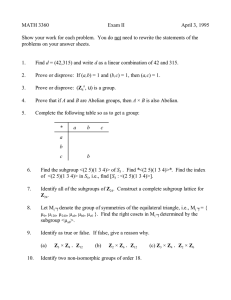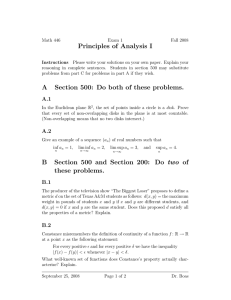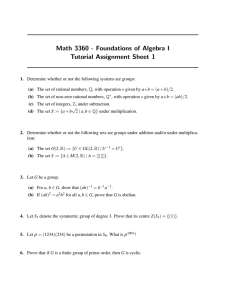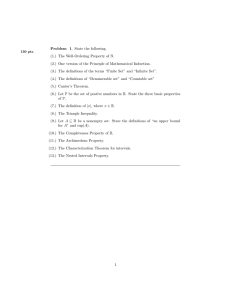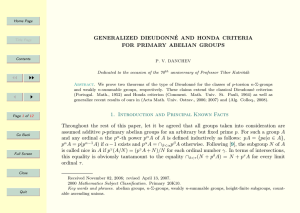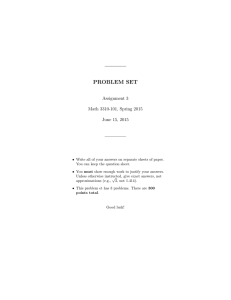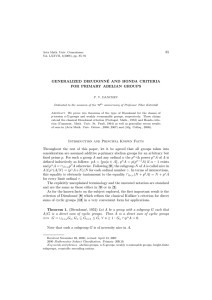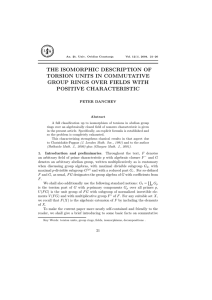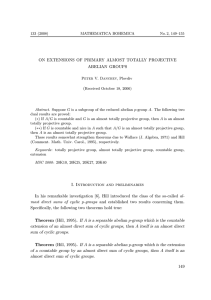NOTES ON COUNTABLE EXTENSIONS p -PROJECTIVES Peter Danchev
advertisement
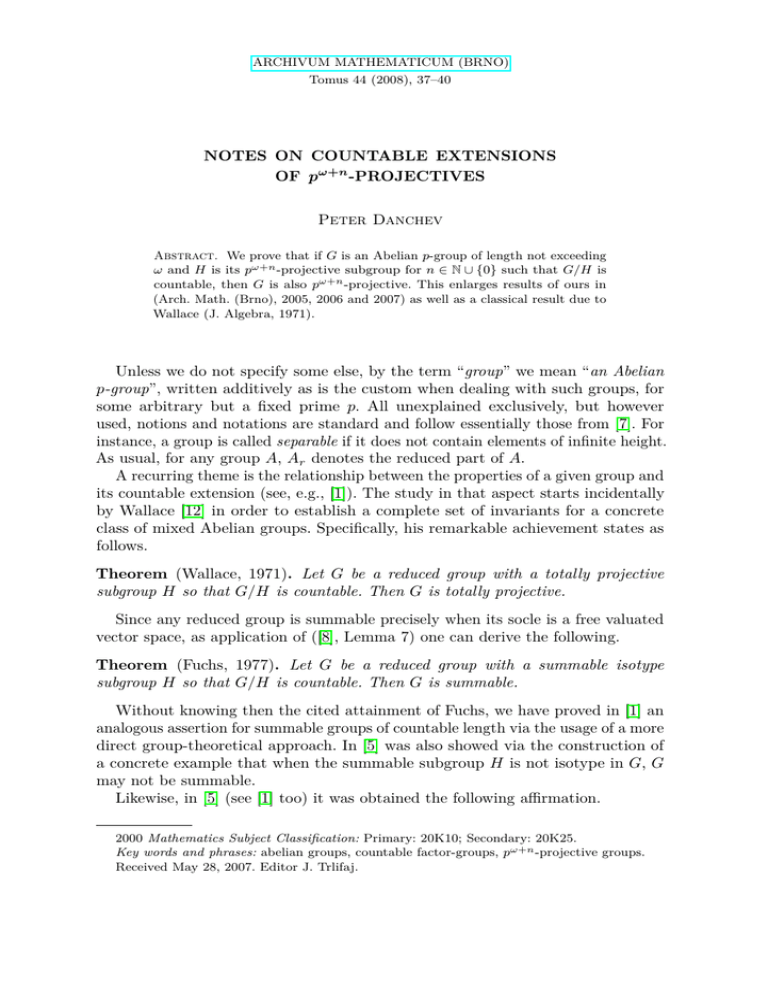
ARCHIVUM MATHEMATICUM (BRNO)
Tomus 44 (2008), 37–40
NOTES ON COUNTABLE EXTENSIONS
OF pω+n -PROJECTIVES
Peter Danchev
Abstract. We prove that if G is an Abelian p-group of length not exceeding
ω and H is its pω+n -projective subgroup for n ∈ N ∪ {0} such that G/H is
countable, then G is also pω+n -projective. This enlarges results of ours in
(Arch. Math. (Brno), 2005, 2006 and 2007) as well as a classical result due to
Wallace (J. Algebra, 1971).
Unless we do not specify some else, by the term “group” we mean “an Abelian
p-group”, written additively as is the custom when dealing with such groups, for
some arbitrary but a fixed prime p. All unexplained exclusively, but however
used, notions and notations are standard and follow essentially those from [7]. For
instance, a group is called separable if it does not contain elements of infinite height.
As usual, for any group A, Ar denotes the reduced part of A.
A recurring theme is the relationship between the properties of a given group and
its countable extension (see, e.g., [1]). The study in that aspect starts incidentally
by Wallace [12] in order to establish a complete set of invariants for a concrete
class of mixed Abelian groups. Specifically, his remarkable achievement states as
follows.
Theorem (Wallace, 1971). Let G be a reduced group with a totally projective
subgroup H so that G/H is countable. Then G is totally projective.
Since any reduced group is summable precisely when its socle is a free valuated
vector space, as application of ([8], Lemma 7) one can derive the following.
Theorem (Fuchs, 1977). Let G be a reduced group with a summable isotype
subgroup H so that G/H is countable. Then G is summable.
Without knowing then the cited attainment of Fuchs, we have proved in [1] an
analogous assertion for summable groups of countable length via the usage of a more
direct group-theoretical approach. In [5] was also showed via the construction of
a concrete example that when the summable subgroup H is not isotype in G, G
may not be summable.
Likewise, in [5] (see [1] too) it was obtained the following affirmation.
2000 Mathematics Subject Classification: Primary: 20K10; Secondary: 20K25.
Key words and phrases: abelian groups, countable factor-groups, pω+n -projective groups.
Received May 28, 2007. Editor J. Trlifaj.
38
P. DANCHEV
Theorem (Danchev and Keef, 2005 and 2008). Let G be a group with a subgroup
H so that G/H is countable. If
(a) H is σ-summable, then G is σ-summable provided that it is of limit length
and H is isotype in G (when H is not isotype in G, G may not be
σ-summable);
(b) H is a Σ-group, then G is a Σ-group;
(c) H is a Q-group, then G is a Q-group provided that it is separable;
(d) H is weakly ω1 -separable, then G is weakly ω1 -separable provided that it is
separable.
In [1] and [3] we have shown the following statement as well.
Theorem (Danchev, 2005 and 2006). Let G be a group with a pω+n -projective
subgroup H so that G/H is countable and n ∈ N ∪ {0}. If
(e) H is pure and nice in G, then G is pω+n -projective;
(f) H is pure in the separable G, then G is pω+n -projective.
Note that in [4] we have established such type results for ω-elongations of totally
projective groups by pω+n -projective groups or summable groups by pω+n -projective
groups, respectively.
The purpose of the present brief work is to discuss some questions as those
alluded to above concerning when a given separable group is pω+n -projective
provided that it has a modulo countable proper pω+n -projective subgroup, but by
removing the pureness of the subgroup in the whole group.
We are now in a position to proceed by proving the next extension of point (f)
(see [5] as well).
Theorem. Suppose that G is a group of length at most ω which contains a subgroup
H such that G/H is countable. Then G is pω+n -projective if and only if H is pω+n -projective, whenever n ∈ N ∪ {0}.
Proof. The necessity is immediate because pω+n -projectives are closed with respect
to subgroups (see, for example, [10]). As for the sufficiency, according to the classical
Nunke’s criterion for pω+n -projectivity (see [10]), there exists P ≤ H[pn ] with H/P
a direct sum of cyclic groups. But observing that (G/P )r /((G/P )r ∩ H/P ) ∼
=
((G/P )r + H/P )/H/P ⊆ G/P/H/P ∼
= G/H is countable with (G/P )r ∩ H/P ⊆
H/P a direct sum of cyclic groups, we appeal to Wallace’s theorem, quoted above,
to infer that (G/P )r is totally projective. Hence G/P is simply presented. Referring
now to [11] (see [7], v. II, too), we deduce that G/P/(G/P )1 = G/P/PG− /P ∼
=
G/PG− is a direct sum of cycles, where PG− = ∩i<ω (P + pi G) is the closure of P
in G. It is a straightforward argument that pn PG− ⊆ pω G. Since G is separable,
that is pω G = 0, we derive that pn PG− = 0, so employing once again the Nunke’s
criterion we are finished.
The condition on separability may be avoided if the following strategy is realizable: Since P is bounded, one can write P = ∪m<ω Pm , where Pm ⊆ Pm+1 ≤ P
with pk Pm = 0 for each m < ω and some k ∈ N. It is readily seen that
NOTES ON COUNTABLE EXTENSIONS OF pω+n -PROJECTIVES
39
PG− = ∪m<ω Km , where Km = ∩i<ω (Pm + pi G). The crucial moment is whether we may choose a nice subgroup N of G such that N ⊆ Pm and such that
Pm ∩ pm G ⊆ N for each integer m ≥ 1; thus P/N is strongly bounded in G/N in
terms of [2]. Consequently, complying with the modular law from [7], we calculate
that Km ∩ pm G = ∩m≤i<ω (Pm + pi G) ∩ pm G = ∩m≤i<ω (Pm ∩ pm G + pi G) ⊆
∩m≤i<ω (N + pi G) = N + ∩m≤i<ω pi G = N + pω G ≤ PG− [pn ]. Furthermore, we
elementarily observe that PG− /(N + pω G) = ∪m<ω [Km /(N + pω G)] where, for each
m < ω, we compute with the aid of the modular law in [7] and the foregoing calculations that (Km /(N + pω G)) ∩ pm (G/(N + pω G)) = [Km ∩ (pm G + N )]/(N + pω G) =
(N + Km ∩ pm G)/(N + pω G) ⊆ (N + pω G)/(N + pω G) = {0}. Besides, by what we
have already shown above, G/(N + pω G)/PG− /(N + pω G) ∼
= G/PG− is a direct sum
of cyclic groups. Knowing this, we apply the Dieudonné’s criterion from [6] (see
also [2]) to deduce that G/(N + pω G) is, in fact, a direct sum of cycles. Hence and
from Nunke’s criterion in [10], we conclude that G is pω+n -projective, as asserted.
This completes our conclusions in all generality.
Remark. Actually, G/P = (G/P )r since pω+n (G/P ) = 0 by seeing that (G/P )1 =
∩i<ω (pi G + P )/P ⊆ G[pn ]/P with P ≤ G[pn ] and G1 = 0. However, our approach
in the proof gives a more general strategy even for inseparable groups. Nevertheless,
this general case is still in question.
A group A is said to be C-decomposable if A = B ⊕ K, where B is a direct sum
of cycles with fin r(B) = fin r(A).
We also pose the following conjecture.
Conjecture. Suppose G is a group whose subgroup H is C-decomposable and
G/H is countable. Then G is C-decomposable.
In closing, we notice that Hill jointly with Megibben have found in ([9], Proposition 1) that if G is a reduced group which possesses a torsion-complete subgroup
H such that G/H ∼
= Z(p∞ ), then G is torsion-complete.
So, we are ready to state the following.
Problem. Suppose G is a group with a subgroup H which belongs to the class
K of Abelian p-groups. If (G/H)[p] is finite, then whether or not G also belongs
to K?
Investigate with a priority when K coincides with the class of thick groups,
torsion-complete groups, semi-complete groups, quasi-complete groups or pure-complete groups, respectively.
It is worthwhile noticing that according to the main result, stated above, the
results from [4] can be improved by dropping off some unnecessary additional
limitations.
References
[1] Danchev, P., Countable extensions of torsion abelian groups, Arch. Math. (Brno) 41 (3)
(2005), 265–272.
[2] Danchev, P., Generalized Dieudonné criterion, Acta Math. Univ. Comenian. 74 (1) (2005),
15–26.
40
P. DANCHEV
[3] Danchev, P., A note on the countable extensions of separable pω+n -projective abelian p-groups,
Arch. Math. (Brno) 42 (3) (2006), 251–254.
[4] Danchev, P., On countable extensions of primary abelian groups, Arch. Math. (Brno) 43 (1)
(2007), 61–66.
[5] Danchev, P., Keef, P., Generalized Wallace theorems, Math. Scand. (to appear).
[6] Dieudonné, J., Sur les p-groupes abeliens infinis, Portugal. Math. 11 (1) (1952), 1–5.
[7] Fuchs, L., Infinite Abelian Groups, I, II, Mir, Moskva, 1974 and 1977, (in Russian).
[8] Fuchs, L., Subfree valued vector spaces, Lecture Notes in Math. 616 (1977), 158–167.
[9] Hill, P., Megibben, C., Extensions of torsion-complete groups, Proc. Amer. Math. Soc. 44
(2) (1974), 259–262.
[10] Nunke, R., Topics in Abelian Groups, ch. Purity and subfunctors of the identity, pp. 121–171,
Scott, Foresman and Co., Chicago, 1963.
[11] Nunke, R., Homology and direct sums of countable abelian groups, Math. Z. 101 (3) (1967),
182–212.
[12] Wallace, K., On mixed groups of torsion-free rank one with totally projective primary
components, J. Algebra 17 (4) (1971), 482–488.
13, General Kutuzov Street, bl. 7, floor 2, flat 4
4003 Plovdiv, Bulgaria
E-mail: pvdanchev@yahoo.com

